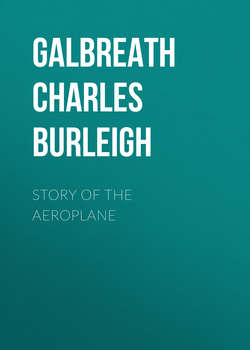Читать книгу Story of the Aeroplane - Galbreath Charles Burleigh - Страница 6
Langley’s Tandem Monoplane
ОглавлениеAbout this time two Americans, Samuel Pierpont Langley, of the Smithsonian Institution and Octave Chanute were conducting along scientific lines a series of experiments in aviation. On May 6, 1896, a steam-propelled model was started in a flight over the Potomac River. Dr. Alexander Graham Bell, the inventor of the telephone, who was present, declared that after a flight of eighty to one hundred feet the machine “settled down so softly that it touched the water without the least shock and was in fact immediately ready for a second trial.” Other experiments were tried with success.
Langley’s first machine was a tandem monoplane, that is it had two pairs of wings, one immediately following the other. The engine and the propellers were between the two pairs of wings. In later models he used the biplane construction.
Finally the United States government appropriated $50,000 to build a machine that would carry a passenger. In constructing this, Langley equipped it with a gasoline engine of about three horse power. The machine was comparatively light, weighing all told only fifty-eight pounds. On August 8, 1903, a public test was made “without a pilot,” on the Potomac River near Washington. Spectators and reporters congratulated the inventor on the success of the experiment, while he with modest satisfaction said, “This is the first time in history, so far as I know, that a successful flight of a mechanically sustained flying machine has been made in public.” This statement was no doubt true of machines of any considerable size, but as we shall presently see, toy flying machines of the helicopter type had long ere this been exhibited to the wondering gaze of boys who were ultimately to bring to a practical conclusion man’s long line of effort to rise triumphant and shape his course through the ocean of air.
Langley’s machine had flown without a pilot. A little later the inventor announced himself ready for the final test. Like his first model, his machine was a tandem monoplane. Its weight with pilot was 830 pounds and its plane or wing surface was 1040 square feet. It was fifty-two feet long and its arched wings measured forty-eight feet from tip to tip. The gasoline motor with which it was equipped developed fifty-two horse power and with all accessories weighed about 250 pounds.
At Widewater, Virginia, September 7, 1903, the machine was tested. On a barge it was carried out into the Potomac River, with Charles M. Manley, Professor Langley’s assistant, who was to pilot it in its first flight. The moment for the supreme test arrived. A mechanical device on the barge shot the machine and pilot into the air. To the disappointment and dismay of the spectators, the machine plunged front downward into the water. It was rescued with the young pilot unharmed. Another attempt was made to launch it in the air with a similar result, except that this time it dropped into the water rear end downward. The government gave the project no further encouragement, and the query ascribed to Darius Green remained unanswered. Professor Langley died a few years afterward, his life shortened, it is believed, through the blighting of the hope that he had long entertained to be the first successfully to navigate the air.
